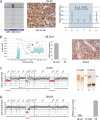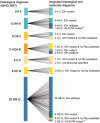Molecular Diagnostics of Gliomas Using Next Generation Sequencing of a Glioma-Tailored Gene Panel
- PMID: 26919320
- PMCID: PMC8029406
- DOI: 10.1111/bpa.12367
Molecular Diagnostics of Gliomas Using Next Generation Sequencing of a Glioma-Tailored Gene Panel
Abstract
Current classification of gliomas is based on histological criteria according to the World Health Organization (WHO) classification of tumors of the central nervous system. Over the past years, characteristic genetic profiles have been identified in various glioma types. These can refine tumor diagnostics and provide important prognostic and predictive information. We report on the establishment and validation of gene panel next generation sequencing (NGS) for the molecular diagnostics of gliomas. We designed a glioma-tailored gene panel covering 660 amplicons derived from 20 genes frequently aberrant in different glioma types. Sensitivity and specificity of glioma gene panel NGS for detection of DNA sequence variants and copy number changes were validated by single gene analyses. NGS-based mutation detection was optimized for application on formalin-fixed paraffin-embedded tissue specimens including small stereotactic biopsy samples. NGS data obtained in a retrospective analysis of 121 gliomas allowed for their molecular classification into distinct biological groups, including (i) isocitrate dehydrogenase gene (IDH) 1 or 2 mutant astrocytic gliomas with frequent α-thalassemia/mental retardation syndrome X-linked (ATRX) and tumor protein p53 (TP53) gene mutations, (ii) IDH mutant oligodendroglial tumors with 1p/19q codeletion, telomerase reverse transcriptase (TERT) promoter mutation and frequent Drosophila homolog of capicua (CIC) gene mutation, as well as (iii) IDH wildtype glioblastomas with frequent TERT promoter mutation, phosphatase and tensin homolog (PTEN) mutation and/or epidermal growth factor receptor (EGFR) amplification. Oligoastrocytic gliomas were genetically assigned to either of these groups. Our findings implicate gene panel NGS as a promising diagnostic technique that may facilitate integrated histological and molecular glioma classification.
Keywords: glioma; molecular diagnostics; mutation; next generation sequencing.
© 2016 International Society of Neuropathology.
Figures



Similar articles
-
Targeted next-generation sequencing of adult gliomas for retrospective prognostic evaluation and up-front diagnostics.Neuropathol Appl Neurobiol. 2021 Feb;47(1):108-126. doi: 10.1111/nan.12645. Epub 2020 Aug 17. Neuropathol Appl Neurobiol. 2021. PMID: 32696543
-
A tailored next-generation sequencing panel identified distinct subtypes of wildtype IDH and TERT promoter glioblastomas.Cancer Sci. 2020 Oct;111(10):3902-3911. doi: 10.1111/cas.14597. Epub 2020 Sep 6. Cancer Sci. 2020. PMID: 32748499 Free PMC article.
-
Molecular classification of anaplastic oligodendroglioma using next-generation sequencing: a report of the prospective randomized EORTC Brain Tumor Group 26951 phase III trial.Neuro Oncol. 2016 Mar;18(3):388-400. doi: 10.1093/neuonc/nov182. Epub 2015 Sep 9. Neuro Oncol. 2016. PMID: 26354927 Free PMC article. Clinical Trial.
-
Integrated diagnostics of diffuse astrocytic and oligodendroglial tumors.Pathologe. 2019 Jun;40(Suppl 1):9-17. doi: 10.1007/s00292-019-0581-8. Pathologe. 2019. PMID: 31025086 Review. English.
-
Correlation between IDH, ATRX, and TERT promoter mutations in glioma.Brain Tumor Pathol. 2020 Apr;37(2):33-40. doi: 10.1007/s10014-020-00360-4. Epub 2020 Mar 29. Brain Tumor Pathol. 2020. PMID: 32227259 Review.
Cited by
-
Proteome-based insights for IDH-mutant glioma classification.Cell Rep Med. 2023 Jan 17;4(1):100909. doi: 10.1016/j.xcrm.2022.100909. Cell Rep Med. 2023. PMID: 36652918 Free PMC article.
-
Molecular profile and clinical features of patients with gliomas using a broad targeted next generation-sequencing panel.Oncol Lett. 2022 Dec 8;25(1):38. doi: 10.3892/ol.2022.13624. eCollection 2023 Jan. Oncol Lett. 2022. PMID: 36589665 Free PMC article.
-
Machine learning modeling of genome-wide copy number alteration signatures reliably predicts IDH mutational status in adult diffuse glioma.Acta Neuropathol Commun. 2021 Dec 4;9(1):191. doi: 10.1186/s40478-021-01295-3. Acta Neuropathol Commun. 2021. PMID: 34863298 Free PMC article.
-
Distribution and favorable prognostic implication of genomic EGFR alterations in IDH-wildtype glioblastoma.Cancer Med. 2023 Jan;12(1):49-60. doi: 10.1002/cam4.4939. Epub 2022 Jun 13. Cancer Med. 2023. PMID: 35695190 Free PMC article.
-
RhoA regulates translation of the Nogo-A decoy SPARC in white matter-invading glioblastomas.Acta Neuropathol. 2019 Aug;138(2):275-293. doi: 10.1007/s00401-019-02021-z. Epub 2019 May 6. Acta Neuropathol. 2019. PMID: 31062076 Free PMC article.
References
-
- Appin CL, Brat DJ (2015) Molecular pathways in gliomagenesis and their relevance to neuropathologic diagnosis. Adv Anat Pathol 22:50–58. - PubMed
Publication types
MeSH terms
Substances
Supplementary concepts
LinkOut - more resources
Full Text Sources
Other Literature Sources
Research Materials
Miscellaneous

